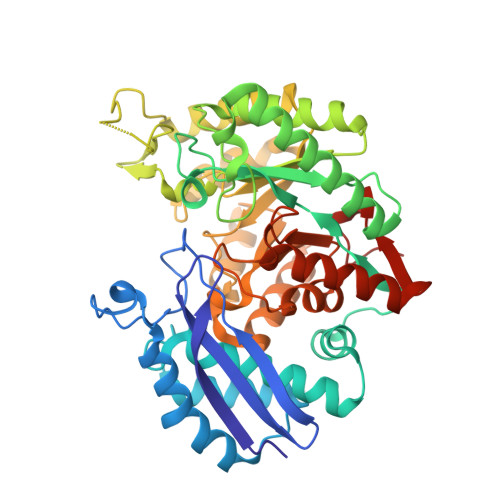Engineering the Enolase Magnesium II Binding Site -Implications for its Evolution.
Schreier, B., Hoecker, B.(2010) Biochemistry 49: 7582
- PubMed: 20690637
- DOI: https://doi.org/10.1021/bi100954f
- Primary Citation of Related Structures:
2XGZ, 2XH0, 2XH2, 2XH4, 2XH7 - PubMed Abstract:
The glycolytic enzyme enolase catalyzes the reversible elimination of water from 2-phosphoglycerate (2-PGA) to form phosphoenolpyruvate (PEP). Two magnesium ions in the active site are thought to facilitate the reaction by activation of the C2 proton of 2-PGA and charge stabilization of the intermediate. The initial abstraction of a proton from a carboxylic acid is common to all members of the enolase superfamily, yet in all other known members of this superfamily, only one magnesium ion (MgI) per active site is sufficient to promote catalysis. We wanted to further investigate the importance of the second magnesium ion (MgII) for the catalytic mechanism of yeast enolase 1. Toward this end, we removed all MgII coordinating residues and replaced substrate-MgII interactions by introducing positively charged side chains. High-resolution crystal structures and activity assays show that the introduced positively charged side chains effectively prohibit MgII binding but fail to promote catalysis. We conclude that enolase is inactive without MgII, yet control mutants without additional positively charged side chains retain basal enolase activity through binding of magnesium to 2-PGA in an open active site without the help of MgII coordinating residues. Thus, we believe that ancestral enolase activity might have evolved in a member of the enolase superfamily that provides only the necessary catalytic residues and the binding site for MgI. Additionally, precatalytic binding of 2-PGA to the apo state of enolase was observed.
Organizational Affiliation:
Max Planck Institute for Developmental Biology, Spemannstrasse 35, 72076 Tübingen, Germany.
















